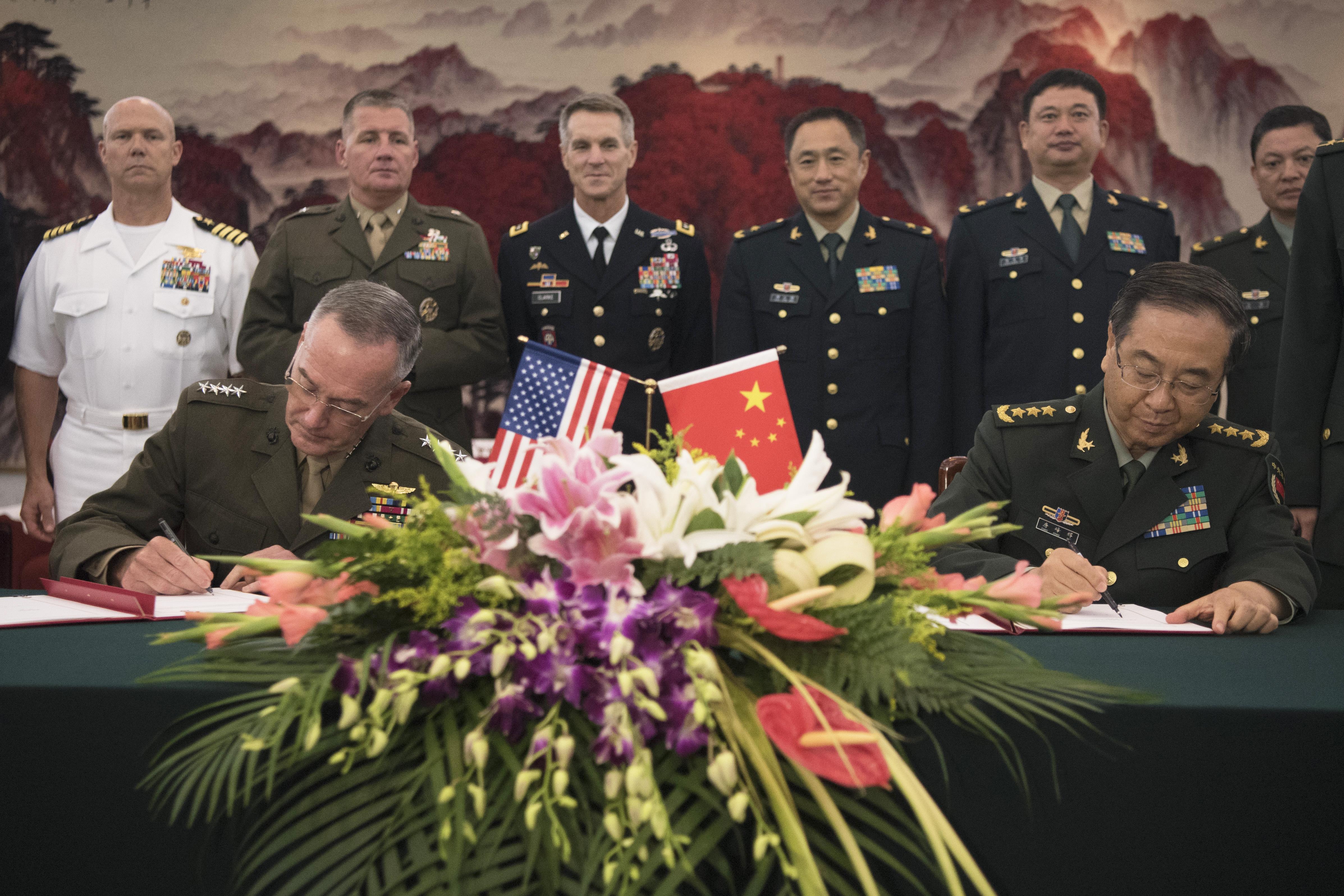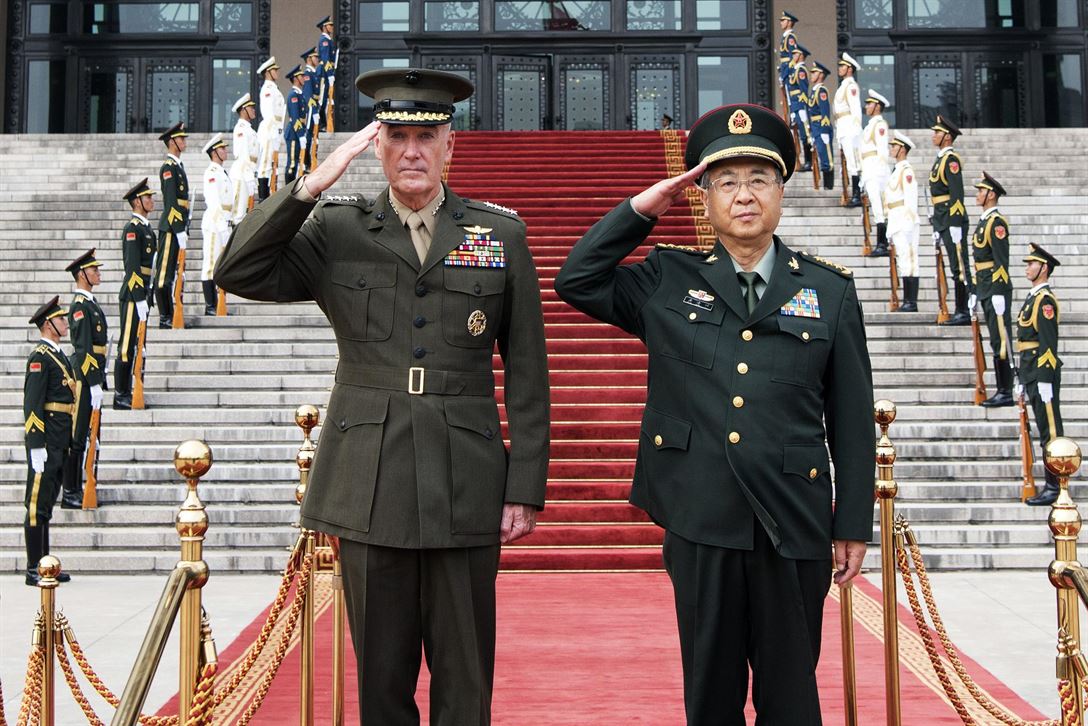
Creating a means for quickly de-escalating tense operations is the goal of a recently signed communications agreement between military leaders from the United States and China.
Marine Corps Gen. Joe Dunford, chairman of the Joint Chiefs of Staff, and Gen. Fang Fenghui of the Chinese army, chief of China’s joint staff, signed a joint strategic dialogue mechanism at the Ba Yi, the People’s Liberation Army headquarters in Beijing on Tuesday.
Dunford, visiting China to further military-to-military ties between the two Pacific powers, was formalizing what had been an idea discussed by leaders from the U.S. and Chinese navies for several years.
These communications are especially crucial now, as the region and world are facing the dangers of a nuclear-armed North Korea, said a statement released by the Joint Staff, the Pentagon said.
Maintaining high-level lines of communication with regional powers has become something of a practice for Dunford. Similar to this week’s meeting in China, Dunford traveled to Baku, Azerbaijan, in February to meet with his Russian counterpart, Gen. Valery Gerasimov. The two military leaders discussed improving communications between the two nations’ militaries.
 After returning to Washington, Dunford described the meeting while speaking at the Brookings Institute
After returning to Washington, Dunford described the meeting while speaking at the Brookings Institute
, saying its purpose was “to make sure we mitigate the risk of miscommunication” that could create an international incident.
The U.S. and Chinese joint strategic dialogue mechanism is the result of several years of high-level discussions between officials from both navies. Diplomatic and security talks in Washington earlier this year helped finalize the agreement.
The agreement is intended for crisis mitigation, said a statement released by U.S. Joint Staff officials. Direct communication at the three-star level in the Pentagon and the Ba Yi will “enable us to communicate to reduce the risk of miscalculation.”
In 2017, the U.S. Navy has conducted three freedom of navigation operations past artificial islands China has created with the goal of extending the nation’s territorial waters, and any claims to fishing and mineral rights.
Meanwhile, in recent years a spate of incidents involving aircraft from U.S. Navy and Chinese Liberation Army Airforce occurring international airspace have created the type of fast-moving situations the new joint strategic dialogue mechanism is supposed to quickly diffuse.
China instituted a so-called Air Defense Identification Zone over the East China Sea, insisting aircraft operating in the zone declare their intentions to Chinese air traffic controllers and the military. The U.S. views this area as unrestricted international airspace and does not comply with Beijing’s directive.
Perhaps the most notorious recent incident occurred in 2014, between a Shenyang J-11BH fighter and a P-8A Poseidon Maritime Surveillance aircraft. The fighter allegedly flew a barrel roll over the Poseidon to show the U.S. crew its weapons loadout. The Chinese said afterward the U.S. aircraft provoked the incident by operating so close to the Chinese shore – albeit in international airspace.
The incident between the P-8A and the J-11 is so famous in China that a painting of the encounter was widely circulated on the Chinese microblog site, Weibo.

The idea of formalizing a communications agreement, though, has been worked on even while such incidents have occurred.
A year ago, when Chief of Naval Operations Adm. John Richardson met in Beijing with his Chinese counterpart, Adm. Wu Shengli, the purpose was discussing ways to increase beneficial meetings, port calls, and improving the cooperation when the two navies operate in international waters.
Former Chief of Naval Operations Adm. Jonathan Greenert met with Shengli several times to also discuss ways of improving communication between the two navies.
Former Chief of Naval Operations Adm. Jonathan Greenert met with Shengli several times to also discuss ways of improving communication between the two navies.
“The key to a peaceful maritime future between China and the U.S. will be rooted in additional engagement between the countries’ navies,” said Greenert in 2014, speaking at the Center for Strategic and International Studies and U.S. Naval Institute’s Maritime Security Dialogue.
“The key to a peaceful maritime future between China and the U.S. will be rooted in additional engagement between the countries’ navies,” said Greenert in 2014, speaking at the Center for Strategic and International Studies and U.S. Naval Institute’s Maritime Security Dialogue.
Army Lt. Gen. Richard D. Clarke, the Joint Staff’s director for strategic plans and policy, will lead the effort for the American military. The first meeting between U.S. and Chinese officials to set up the framework is expected to occur in November.





